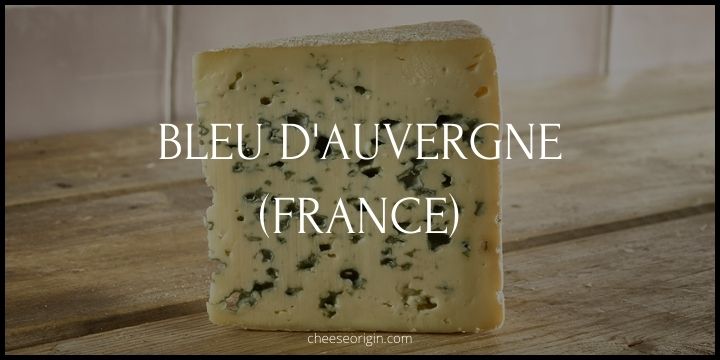What is Bleu d’Auvergne? The Quintessential French Blue Cheese

Today, we’re diving into the rich, creamy depths of one of France’s most beloved blue cheeses – Bleu d’Auvergne.
This exquisite cheese, hailing from the rugged volcanic region of Auvergne, has been tantalizing palates for centuries. With its distinctive blue-green veins, piquant aroma, and complex flavor profile, Bleu d’Auvergne embodies the very essence of French culinary artistry.
Join us as we embark on a journey to unravel the mysteries of this quintessential French blue cheese, exploring its origins, the secrets behind its unique characteristics, and the ways you can savor it to its fullest.
Quick Facts About Bleu d’Auvergne
| Country of Origin | France |
| Region | Auvergne |
| Age | 2 to 3 months (Aged for at least four weeks, but some variants can be aged up to several months for a more pronounced flavor.) |
| AOC | 1975 |
| Creation | Developed in the mid-1850s by a French cheesemaker named Antoine Roussel. |
| Classification | Blue |
| Milk | Raw or pasteurized Cow’s milk |
| Weight and shape | 2.5 kg (5.5 lb), Drum |
| Fat content | 50% |
| Size | Diameter 20 cm (8 inches), Height 10 cm (4 inches) |
| Aroma | Strong |
| Taste | Creamy, buttery, spicy, and salty with hints of wildflower |
| Pairing | Chicory, nuts, truffle honey, strong red or sweet white wines |
| Texture | Rind: Moist, sticky; Paste: Creamy, smooth |
| Color | Ivory, dotted with blue-green mold |
What is Bleu d’Auvergne?
Bleu d’Auvergne is a traditional French cheese originating from the Auvergne region in South Central France. It’s a type of blue cheese, known for its strong and pungent flavor and distinctive blue-green veins of mold.
This cheese is made from cow’s milk and has a creamy and crumbly texture. The flavor profile is robust with hints of wild mushrooms and grass, reflecting the natural pastures where the cows graze. Despite its strong flavor, it is less salty than other blue cheeses.
The cheese was first created in the mid-19th century by a French cheesemaker named Antoine Roussel. He noted the role of rye bread in developing molds and applied the process to cheese production.
In 1975, Bleu d’Auvergne was granted Appellation d’Origine Contrôlée (AOC) status. This means that every step of its production, from the milking of the cows to the aging of the cheese, is regulated according to strict guidelines to ensure quality and authenticity.
Bleu d’Auvergne is often enjoyed with crusty bread and pairs well with sweet wines like Port or full-bodied red wines like Syrah. It can also be used in cooking, adding a unique flavor to dishes like salads, pastas, and pizzas.
What Does Bleu d’Auvergne Taste Like
Bleu d’Auvergne has a unique, robust flavor profile. It’s known for its strong and pungent taste, but it is less salty compared to other blue cheeses. The flavor has been described as a balance of sweet, spicy, and salty notes with a hint of wild mushrooms and grass, reflecting the natural pastures where the cows graze.
The cheese also has a creamy and buttery mouthfeel that contrasts with the sharpness of the blue mold. As it ages, its flavor becomes more pronounced and complex, gaining a sharper, tangier edge.
The aftertaste of Bleu d’Auvergne is often long-lasting, leaving a pleasant, slightly spicy sensation on the palate. This makes it a great choice for pairing with sweet wines like Port or bold, full-bodied red wines like Syrah, which can stand up to its strong flavor.
Bleu d’Auvergne Tasting Notes
This cheese is made using cow’s milk, salt, rennet, and penicillium roqueforti and is aged for a minimum of 4 weeks.
- Appearance: Bleu d’Auvergne has a natural, sticky rind with blue-green mold veins evenly distributed throughout its moist, creamy interior.
- Texture: The cheese is semi-hard, crumbly yet creamy, and melts easily in the mouth.
- Smell: It has an earthy aroma with hints of damp soil and fresh mushrooms.
- Taste: The flavor profile of Bleu d’Auvergne is robust and complex. It has a balance of sweet, spicy, and salty notes. Despite being a blue cheese, it is less salty than others of its kind.
- Aftertaste: The aftertaste is long-lasting, leaving a pleasant, slightly spicy sensation on the palate.
- Pairing: This cheese pairs well with sweet wines like Port or bold, full-bodied red wines like Syrah. It also complements well with fruits such as pears and apples, and can be enjoyed with crusty bread or used in various dishes like salads, pasta, and pizzas.
What Pairs Well With Bleu d’Auvergne?
Food that goes well with Bleu d’Auvergne:
Sure, here’s a table detailing foods that pair well with Bleu d’Auvergne:
| Category | Foods |
|---|---|
| Fruits | Pears, Apples, Figs |
| Nuts | Walnuts, Hazelnuts |
| Breads | Crusty Bread, Rye Bread |
| Salads | Mâche Salad (with roasted pears, hazelnuts, and walnuts) |
These pairings are based on the unique flavor profile of Bleu d’Auvergne, which includes a balance of sweet, spicy, and salty notes. The fruits and nuts provide a contrasting sweetness and crunch to the creamy and robust cheese.
The breads serve as a neutral base that allows the cheese’s flavors to shine. The salads and other recipes incorporate Bleu d’Auvergne to enhance their overall taste and complexity.
Also read: What Fruit Goes on a Charcuterie Board?
Beverage that goes well with Bleu d’Auvergne:
Sure! Here’s a table detailing beverages that pair well with Bleu d’Auvergne:
| Category | Beverages |
|---|---|
| Red Wine | Syrah, Cabernet Sauvignon, Merlot, Bordeaux, Shiraz, Zinfandel |
| White Wine | Sweet Sauternes, Late Harvest Riesling, Sauvignon blanc |
| Dessert Wine | Port, Sherry |
| Beer | Stout, Belgian Dubbel, IPA |
| Non-Alcoholic | Sparkling Apple Cider, Grape Juice |
The robust and complex flavors of this cheese can stand up to bold red wines, while sweet white and dessert wines provide a nice contrast.
Similarly, the strong flavors in stout and Belgian beers can balance the cheese’s pungency. Non-alcoholic beverages like sparkling apple cider and grape juice offer a fruity and refreshing counterpoint.
Also read: Best Wine and Cheese Pairings: The Ultimate Guide
The History and Origin of Bleu d’Auvergne
Bleu d’Auvergne, a quintessential French blue cheese, has a rich history that dates back to the mid-19th century. It was born out of the passion of a farmer working 40km west of Clermont-Ferrand in the Auvergne region of south-central France. In his pursuit of a perfect cheese, he came up with the innovative idea of sprinkling mold from rye bread on his milk curd and then piercing the curd with a needle. This allowed air through and fostered the development of the cheese’s signature blue-green veins.
The story of Bleu d’Auvergne actually began in the département of Cantal, a region of lush green meadows located southwest of Clermont Ferrand. It was here that generations of Cantal farmers perfected the art of cheesemaking, laying down a foundation that would eventually give rise to Bleu d’Auvergne.
The name “Bleu d’Auvergne” is a tribute to its place of origin. The cheese can be made from raw or pasteurized cow’s milk, offering a distinct flavor profile that’s a testament to the quality of the local milk and the unique cheesemaking techniques employed.
Over time, Bleu d’Auvergne has earned a reputation for being a rich, charming, and mildly piquant cheese that’s beloved not just in France, but around the world. Its creation is a testament to the ingenuity and dedication of French farmers and their commitment to preserving and celebrating their culinary heritage.
Where to Buy Bleu d’Auvergne:
- gourmetfoodstore.com – 1 lb for $11.53
- stamfordcheese.com – 500 g for £12.50
- murrayscheese.com – 1 lb for $24.00
- artisanalcheese.com – 0.5 lb for $9.00
More Cheeses from France:







